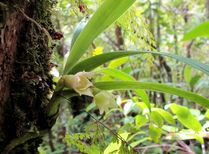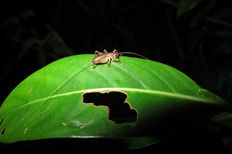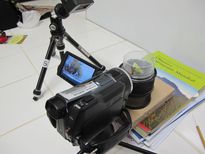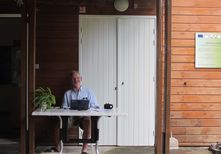February 5th to 19th, 2014
Mouthparts and feeding behaviour of Glomeremus orchidophilus (Gryllacridiae)
Harald W. Krenn, Department of Integrative Zoology, University of Vienna, Austria
"Insect mouthparts offer ample opportunity to study form and function in evolutionary context. Various adaptations to floral food sources can be found in the different feeding guilds of flower-visiting insects. The functional morphology of their mouthparts represents the scientific goal of my research group at the University of Vienna (Austria).
The recently discovered, orchid-pollinating raspy cricket, Glomeremus orchidophilus, is a unique example among the flower visiting insects since they represent the only reported case of a pollinating cricket, so far. The crickets are able to take up nectar from flowers of the orchid Angreacum cardetti although they possess a biting-chewing type of mouthparts. During the nocturnal flower-visits, Glomeremus orchidophilus act as pollinators of the orchid Angreacum cardetti. This is an amazing example of an omnivorous cricket that feed on nectar. It is not known whether adaptations of the biting-chewing mouthparts to fluid feeding evolved in Glomeremus. Therefore, the main research goal was to search for structural and/or behavioral adaptations to nectar-feeding in Glomeremus orchidophilus.
The Marelongue Research Station (Saint-Philipp) turned out to be an excellent place to study the nocturnal cricket, Glomeremus orchidophilus. With the help of Jacques Fournel and Sylvain Hugel (University of Strasbourg), these insects could be collected during several nights in the forests of the Parc National de La Réunion close to the station. Feeding experiments and video recordings were performed in the station to find out which mouthparts structures are used for fluid uptake on artificial and natural food sources. Ten individuals were preserved in ethanol (permit Parc National de La Réunion Autorisation N° DIR/i/2014/002) for subsequent morphological studies at the University of Vienna. The aim of these ongoing comparative micromorphological studies is to examine the ultrastructure of the mouthparts, e.g., cuticle surface, in advanced fluorescence microscopy and SEM.
In summary, the research stay in the Marelongue Research Station (Saint-Philipp) was very successful and I thank Audrey Valery and Dominique Strasberg (University of La Réunion) for logistic and administrative help for my scientific work."



